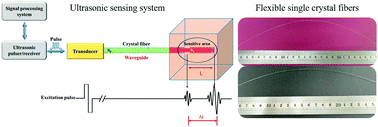Fabrication and sensitivity optimization of garnet crystal-fiber ultrasonic temperature sensor
Abstract
In this work, we combine ultrasonic temperature sensing technology with single crystal fibers (SCFs) and demonstrate the performance of a high-sensitivity ultrasonic temperature sensor using YAG and LuAG crystal fibers. The high sensitivity of the sensor facilitates precision temperature sensing. We systematically explored the effects of the ultrasonic mode, doping concentration, and crystal orientation on the sensitivity of the sensor. The results illustrate that transverse waves (S-waves) are better suited to achieving high unit sensitivity compared to longitudinal waves (P-waves), by a factor of approximately 1.5. It was also determined that the unit sensitivity of the sensor, anisotropic, and increases with the increase of doping concentration within a specific range. We found that the [111]-oriented garnet crystal fiber sensors have a lower ultrasonic velocity at high temperature, and therefore possess higher unit sensitivity. The mean unit sensitivity of the [111]-oriented 10 at% Yb:LuAG SCF ultrasonic sensor in the range of 20–1100 °C was optimized to 25.21–34.83 ns °C−1 m−1, which is more than 50% higher than that of the pure YAG SCF sensor. Meanwhile, the obtained crystal fiber sensors demonstrate excellent stability at high temperature with the standard deviation of the mean unit sensitivity being less than ±5%. This work represents a feasible approach for enabling high-precision temperature measurement via the ultrasonic technique and crystal design.



 Please wait while we load your content...
Please wait while we load your content...